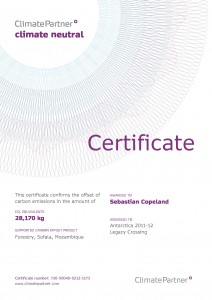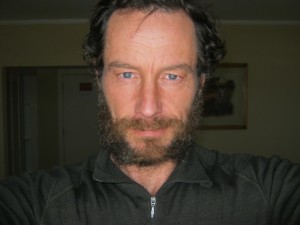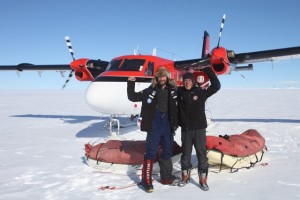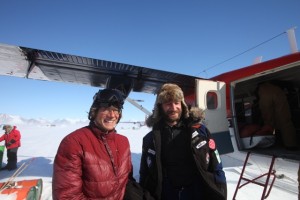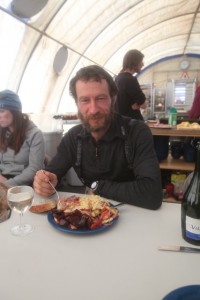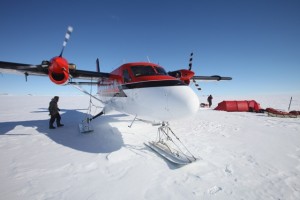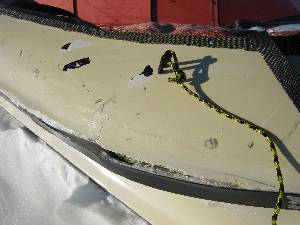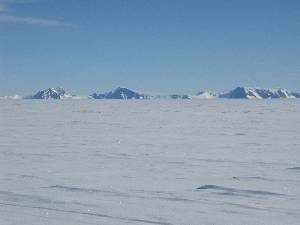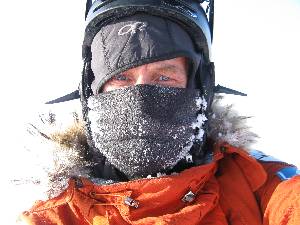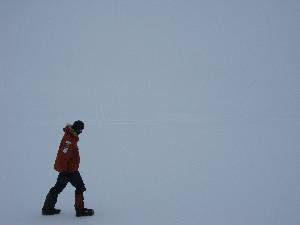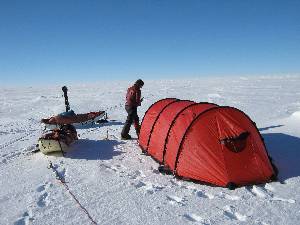January 23, 2012
S79°58.370 W079°43.314
Elevation 712 feet

The day looked promising from the start. Yesterday’s up and down conditions were likely the head of a wind front. From the time we had set up camp, and all through the night, consistent winds had held strong. In the morning, they were still blowing snow on the side of the tent and setting up what looked to be a great travel day. With 230 kilometers left to our trip, those were just the kind of conditions we needed. We hoped to close the gap by end of day.
The thirteen meters were set out at 07:00 hours and immediately shot out of the gate. Our first hour section netted 43 kilometers. The winds grew from there and, for our last day, delivered epic conditions! We quickly switched down to the nine meter kites and stayed on them until the very end. On a broad reach and downwind tack, which has been our heading, kiting overpowered makes for fast, easy and adrenaline-fueled miles. The ice flies below the skis; the terrain races by; the pull on the lines and legs is very manageable. But whatever you do, just don’t crash! At those speeds, it would make for a hell of a yard sale! The scenery was commensurate with the conditions: blowing snow lent a chaotic and wild setting to the landscape. Backlit by the sun, the sastrugi ice was covered by a racing cloud of snow, undulating over the surface like a wave. On our breaks, that snow would hit us with gusts of over forty kilometers per hour; it was chilly and somewhat overwhelming. But once the kite shot up off the ground, generating speeds often exceeding that, the surrounding conditions suddenly felt tamer. We raced along side the blowing snow in what then felt like a graceful, orchestrated choreography. Our tack neutralized the wind, and the chill along with it.
About halfway into our day, we ran into two Australians, Cass and Jonesy, who are setting up to be the first team ever to complete a South Pole and back unsupported skiing trip from Hercules Inlet. We have been following each other’s progress on the ice, as you do with other ambitious expeditions. And again, without having met them previously, instantly felt a brotherhood kinship. We congratulated each other over our impending accomplishments. They asked me about my ribs; I asked Cass about his approaching wedding, especially seeing as I have one coming up myself! We both agreed that thinking about our weddings, and wives-to-be on the trail always brought strength, a smile and a warm feeling in the challenging times. Their progress has been remarkable–they should be three long days from the finish line. It seemed unfair to zip off in front of them, especially with the speeds we were traveling at. From their position, were were hoping to reach Hercules within five hours! In no time, the two black silhouettes that had been sticking out of the ice faded in the blowing snow. We were racing to our own finish line! They disappeared in the distance.
Two hours later, the Ellesworth mountain range appeared like a dot on the horizon, announcing the approaching coastline. We were fifty kilometers away.
The winds held for most of the day, right up to our approach of the Hercules Inlet area. Descending to the Ronne iceshelf amongst glazed ice patches, crevasses and hard, jagged sastrugi would have made strong winds a real nuisance, and a liability. As if on cue, they turned down, almost instantly, to a moderate twelve knots just to accommodate the last hour of our final approach! We could not have hoped for better. Slowly, we negotiated the treacherous terrain, quickly losing elevation: in less than thirty minutes we had dropped two thousand feet. The sun was out; the low altitude raised the temperature; we were baking! The approach route I was given by ALE was remarkably light on crevasses. I was marveling about that to myself when, all of a sudden, I was on top of a set of three small ones. The glazed ice , while moving downhill, made stopping impossible at that point. I chose what looked like a decent bridge, and sped across. One. Two. Three. No harm done! Eric was slightly behind, and looked for an open passage; unable to stop as well, he found another set of bridges and proceeded as I had! We were home free, on our way down the last slope, towards the iceshelf. But suddenly, as in a final wink, Eric’s and my kite simultaneously fell out of the sky, right next to each other. The winds had shut off completely. I looked at my GPS: we were 2.53 kilometers from our landing spot! In a final show of “who’s the boss”, Antarctica was playing its last joke on us. We sat on our sledges for a moment, hoping the winds would come back on. They did not. “I guess that means we’re walking”, I said. “Looks that way”, Eric shot back, in disbelief. Ashes to ashes, dust to dust, we had started walking at the other end of the continent, and walking is how we would finish! We strapped our skis to the top of the sledges, hooked in our pulling traces, and begun our descent. No sooner had we started walking that a weak gust announced some wind… We quickly set up the thirteen’s and lifted them in the air! It was light, but enough to slide down. Some. Within two minutes, they, too, fell out of the sky! That was it. We had done one kilometer! With one and a half left to the trip, we folded the kites and wrapped the lines one last time, then resumed back to our downhill walk, and our conversation.
In addition to winds that held in a remarkably, delivering the best kiting day–hands down–of the entire trip, another extraordinary thing happened today. I have mentioned that my sledge had developed a six inch crack two months ago. That crack remained stable for the following 3500 kilometers, and the worst I can say about it was the amount of stowaway snow it accumulated inside. Yesterday, the crack had started showing increased signs of weakening, and throughout today, the weakening increased to a widening fissure, while the runner under its right ski begun falling apart. I removed some of the contents, and gave them to Eric, to reduce compounded weight. I attempted briefly to strap the trace to the back of the sledge, and pull it backwards; but the unavoidable fishtailing generated while kiting, had disastrous consequences. The crack, now in the rear, was catching the ice while fishtailing and the sledge’s unraveling was precipitated; its right side was utterly falling apart. Eric followed me closely for the final four hours of traveling, so scared I was to lose items from the widening gap. It seemed utterly possible at this point that, with our speeds of travel, the sledge would simply split in half! Instead, it held, worsening incrementally, until our final landing spot. There, a massive crack along its side finally opened, which would have made further travel simply impossible. That sledge had held for the entire trip, just to die, on my lap, on the very last moment! Amazing. A little angel was evidently sitting on my shoulder…
We set down on our final campsite at 22:30 hours. We had been on the trail for close to sixteen hours. We had spent three months crossing the Antarctica continent, from East to West, coast to coast, through two of it poles, over four thousand kilometers and have been the first to do so in the long history of polar expeditions. Eric and I had succeeded in the third and final mandate of this mission. Exhausted, we hugged and laughed. I called ALE, our logistics support team, to report on our position, and was met with enthusiastic and congratulatory exclamations. We will be picked up tomorrow if conditions are favorable. Two days later, we will ship off to Punta Arenas, Chile. Our work here is done: mission accomplished! And now, I could really use a bath!
And now for the numbers:
We covered 231.5 kilometers today.
We left on November 4th, exactly 81 days ago; in that time we covered a total distance of 3854 kilometers (about 4100 adjusted kilometers, or 2500 miles) and arrived one day earlier than my scheduled assumption!
The 1120 kilometers from South Pole, we covered in 12 days for an average of 93.3 kilometers per day, which doubles our daily average for the entire trip–about 47.5 kilometers per day for 81 days.
Interestingly, it also took us 12 days to cover the 880 kilometers separating the POI from the South Pole, for an average there of 73.3 kilometers per day.
Our Novo-POI daily average was just about 34 kilometers per day!
More


